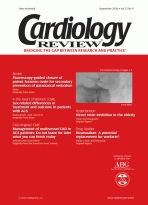Assessing prognosis in heart failure: What is the role of the 6-minute walk test?
Heart failure affects approximately 5 million Americans, and more than 500 000 new cases are diagnosed each year.
Heart failure affects approximately 5 million Americans, and more than 500,000 new cases are diagnosed each year.1 In the past 20 years, therapeutic advances—including angiotensin-converting enzyme (ACE) inhibitors, beta blockers, aldosterone antagonists, implantable cardioverter defibrillators (ICDs), and biventricular pacemakers—have substantially improved the outlook for patients with heart failure. Yet, the overall prognosis remains poor, with 5-year survival rates of less than 50%.2,3 However, there is considerable heterogeneity in the prognosis of heart failure patients, with up to 25% of patients dying within 1 year of diagnosis, while a small percentage survive 10 years or longer.4 And therein lies the importance of developing reasonably reliable methods for assessing prognosis in the heart failure population—to provide guidance to patients and their families, as well as to make rational therapeutic decisions regarding the use of invasive and costly interventions, such as ICDs and biventricular pacemakers.
The 6-minute walk test (6-MWT) is a simple, inexpensive evaluation that can be readily performed in the office setting.5 All that is required is a carefully measured "course," typically 50 to 100 feet long, a watch, and someone to supervise the test, usually a physician or nurse. The patient is instructed to walk back and forth along the course, covering as much distance as possible in 6 minutes. Rest stops and assist devices (eg, a cane) are permitted, and regular encouragement is provided. At the end of the test, the total distance walked is recorded.
Prior studies have shown that the 6-MWT distance correlates with maximal oxygen consumption, functional capacity, quality of life, and prognosis in selected heart failure patients.6-9 The article by Ingle extends the findings of previous studies by showing that the 6-MWT provides independent prognostic information in a broader heart failure population representative of patients typically seen in the community, as evidenced by a median age of 74 years, a proportion of 40% women, and an average left ventricular ejection fraction (LVEF) of 48%. As shown in the
Figure in the article
, subjects with a 6-MWT distance above the median value of 345 m (1132 ft) had a 4-year mortality rate of less than 10%, whereas subjects who walked less than 240 m (787 ft) had a 4-year mortality rate of about 30%.
An interesting and important caveat is that the prognostic value of the 6-MWT was limited to patients with "more than mild" left ventricular systolic dysfunction based on echocardiography. Such patients comprised only 28% of the study population; in the remaining 72% of patients, the 6-MWT was not an independent predictor of prognosis after adjusting for other relevant variables. In the latter subgroup, independent predictors of mortality included female sex, shortness of breath at night, lower hemoglobin level, higher N-terminal proBNP level, and nonprescription of a beta blocker. These findings are consistent with other studies suggesting that factors predicting outcomes in heart failure patients with relatively preserved systolic function differ from those in patients with the more classic syndrome of heart failure and reduced ejection fraction.10
What are the implications of this study for the physician in practice? First, in patients with systolic heart failure, defined as an LVEF < 45%, the 6-MWT provides valuable prognostic information that can guide therapeutic decision making. For example, patients with poor exercise tolerance might benefit from intensified medical therapy or referral to a heart failure specialist. Conversely, unless the prognosis can be improved, such patients may be less than optimal candidates for an ICD because the survival benefit of an ICD is limited during the first 1 to 2 years after implantation.11,12 Second, in patients with heart failure and preserved systolic function (LVEF = 45%), the 6-MWT still provides useful information about functional capacity and quality of life, but it does not appear to aid in the assessment of long-term prognosis.
Several limitations of the current report are worth noting. First, the study population was derived from patients referred to a local community clinic in the United Kingdom. Only 48% of patients were receiving an ACE inhibitor, and only 42% were receiving a beta blocker. Overall mortality during the mean follow-up period of 3 years was only 13.3%, which is much lower than reported in most prior studies.2,3 The study population thus appears to represent a selected subgroup of the heart failure population with a somewhat more favorable prognosis, in whom use of conventional heart failure therapies was less than currently reported in the United States; the applicability of the study findings to a broader, older, "sicker," and more aggressively treated heart failure population remains uncertain. Second, patients unable to walk unassisted because of symptom severity or comorbid orthopedic or neurologic conditions were excluded from the present analysis. The prevalence of such conditions increases with age, and it is likely that the prognosis in these patients is worse than in those who are able to complete the 6-MWT; alternative methods for assessing prognosis in these high-risk patients are therefore needed. Third, despite the simplicity and low-cost of the 6-MWT, it is not widely used in routine care in the United States, primarily because it is inconvenient and time consuming. Although these "excuses" for not performing the test may not be justified, they do raise the question of whether alternate measures of functional capacity, such as the Duke Activity Status Index13 or even the New York Heart Association functional class, might provide equivalent information to the 6-MWT with greater convenience, broader applicability, and even lower cost. The value of these assessments relative to the 6-MWT requires further investigation.
